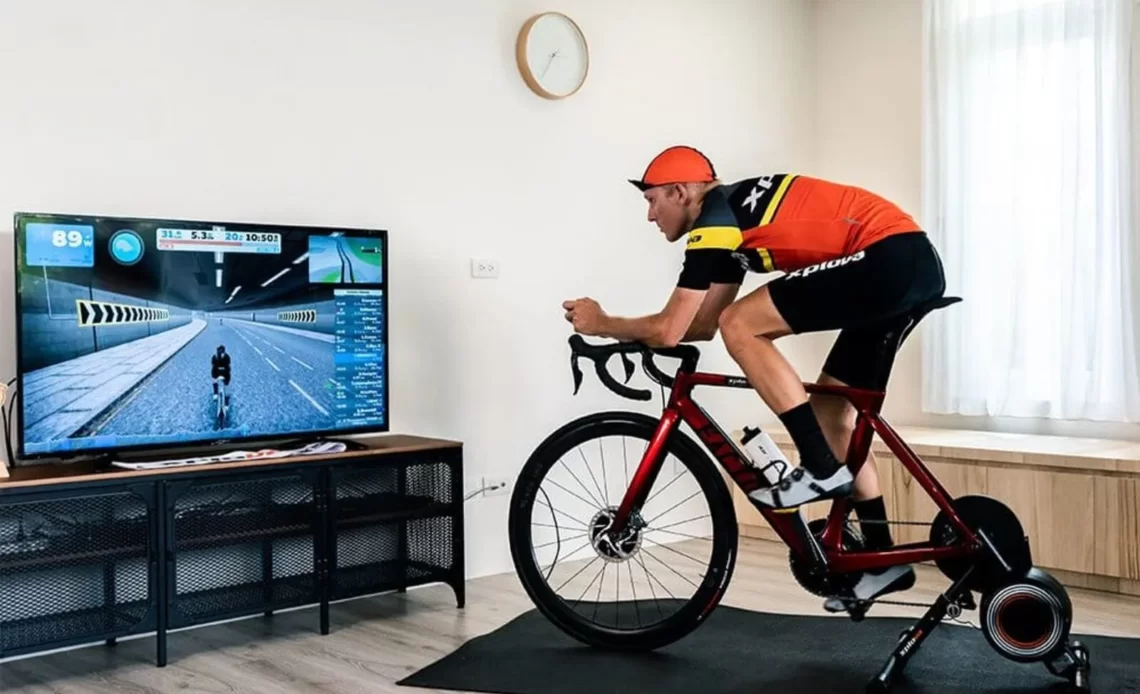Connected Home Trainers: an intriguing alternative to exercise bikes? What’s the value of these increasingly popular machines that allow you to ride from the comfort of your home?
Some are basic “rollers” placed under your wheels. However, today, we’re focused on connected home trainers that optimize your indoor sessions. In this guide, we’ll provide all the essentials for starting home training with your bike. Let’s get started!
The Best Connected Home Trainers
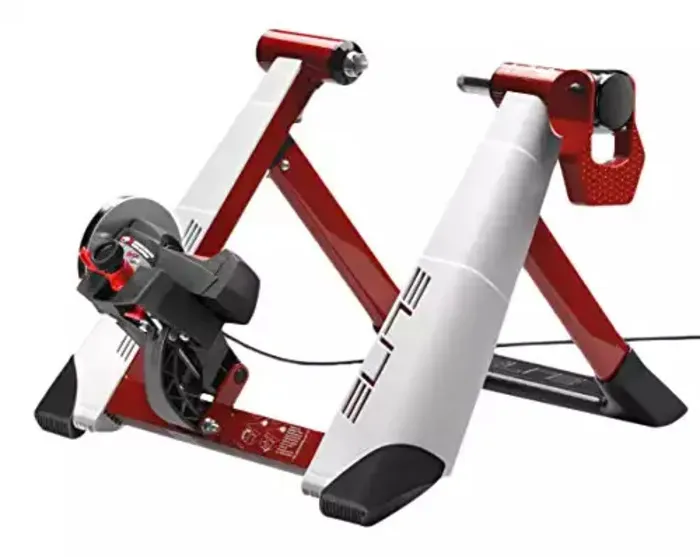
Elite Novo Mag Force
Silent, grippy elastogel roller, 5 resistance levels, fast-fix system and foldable for easy storage.
Resistance: Magnetic | Bicycle type: road | Max load: 286 lbs | Warranty: 2 years
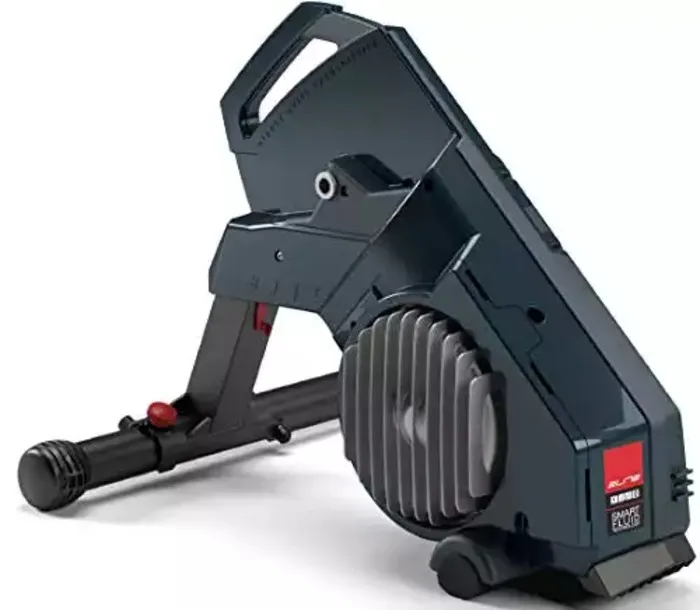
Elite Turno
Compatible with many applications, silent, max power 700W, fluid resistance, ultra-precise Misuro B+ sensor.
Resistance: Fluid | Bicycle type: road | Max load: 286 lbs | Warranty: 2 years
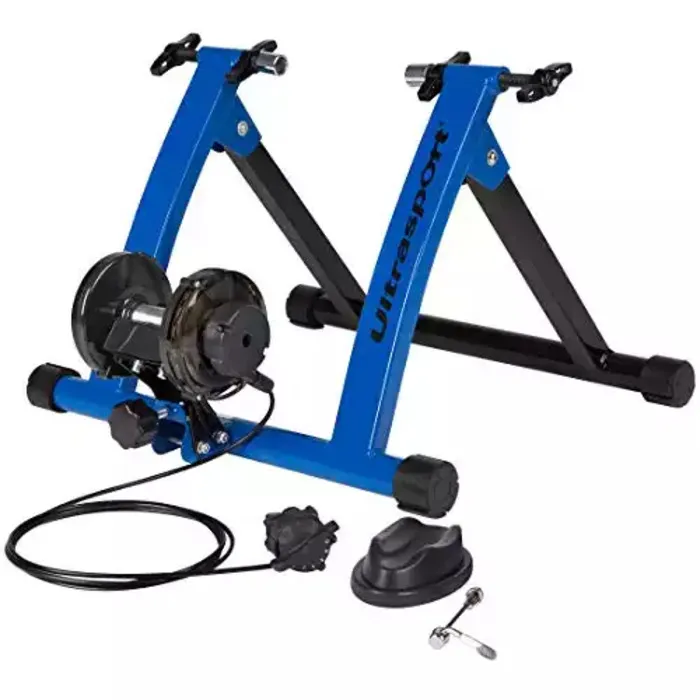
Ultrasport Roller trainer
7 resistance levels, foldable and silent, suitable for all bikes with or without quick-release. Can support up to 220 lbs.
Resistance: Magnetic | Bicycle type: All | Max load: 220 lbs | Warranty: 2 years
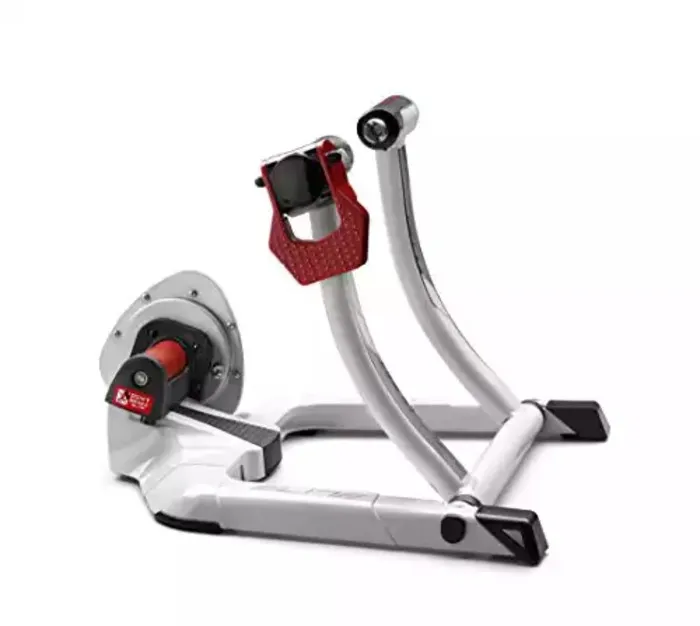
Elite Qubo Fluid
1-gesture fast-fix system, ultra-resistant sensor. Adherent Elastogel roller, compass system to simulate the road.
Resistance: Fluid | Bicycle type: road | Max load: 286 lbs | Warranty: 2 years
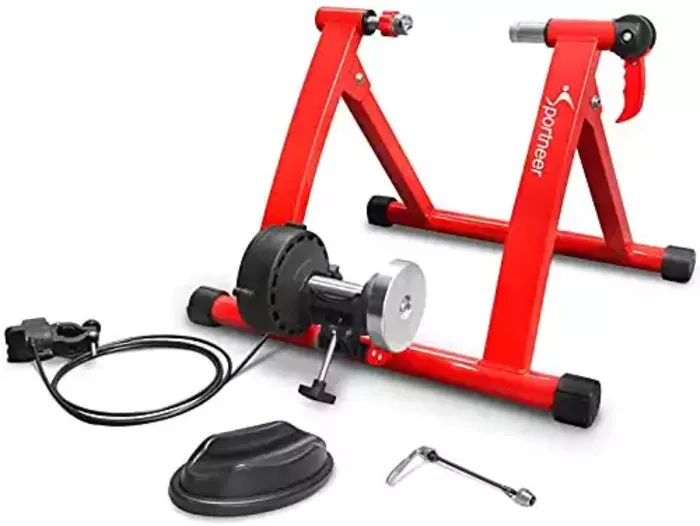
Sportneer
Foldable with noise-reducing wheel, easy to assemble and use with lever clamp. 6 resistance levels.
Resistance: Magnetic | Bicycle type: road | Max load: 220 lbs | Warranty: 1 year
What Exactly Is a Connected Home Trainer?
Interactive and realistic, a connected home trainer enables you to continue your physical preparation or cycling training from home without sacrificing realism. This device replicates road-like sensations flawlessly, showcasing ongoing innovations in the connected sports sector.
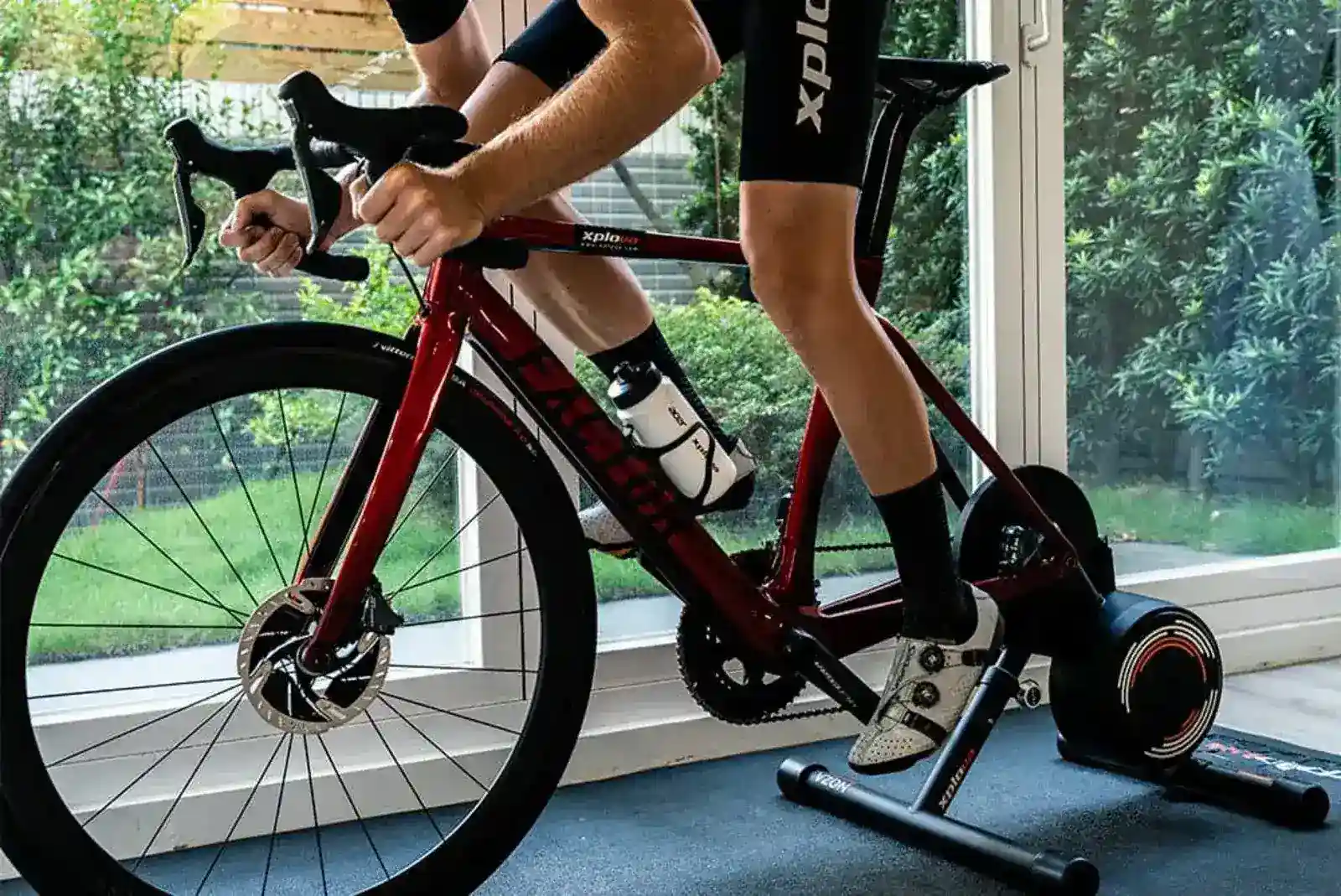
It’s a device that allows you to use your own racing bike indoors. The bike’s wheels run on a cylinder or directly engage with a cassette, allowing real-time adjustment of pedaling difficulty (resistance, incline) to match your session.
Advanced systems linked to the pedaling mechanism make it an outstanding training companion. Whether focusing on strength, speed, aerobics, or sprinting, you can tailor your workouts and monitor your performance on a screen. Primarily utilized during winter, home trainers are increasingly favored by sports enthusiasts for year-round use.
Home Trainer or Exercise Bike: Which Is Better?
By now, you’re acquainted with the primary features of the home trainer, but you’ve likely observed its substantial differences compared to an exercise bike.
By definition, an exercise bike (such as the Sportstech X600) isn’t customized to your bike, resulting in vastly different sensations. A home trainer offers greater ergonomics, as its accessories are easily stored and transportable.
Consider taking your home trainer on vacation or to a competition. You can transport your home trainer in the trunk and your bike in the car without any issue. Elite athletes prefer home trainers for the closest road-like feel minus the jolts, making it an ideal solution post-injury.
Types of Connected Home Trainers
The two most common types encountered are “wheel-on” and “direct-drive” systems.
Wheel-On or Resistance Home Trainers
Typically less costly than “direct-drive” machines, these home trainers simplify rear wheel attachment. They’re beginner-friendly, as the rear wheel doesn’t need removal for indoor sessions.
Initially, it may seem somewhat technical, but you’ll quickly become adept at securing your bike on the axle.
Resistance against the wheel varies due to a roller pressing against the rear wheel. This can be magnetic, motorized, or hydraulic. Higher-tier devices of this type are quieter and more stable.
Direct-Drive Home Trainer
With direct-drive systems, you remove the rear wheel, attaching the entire rear of the bike to the unit. Stability is improved, and road feel is better replicated, in our view.
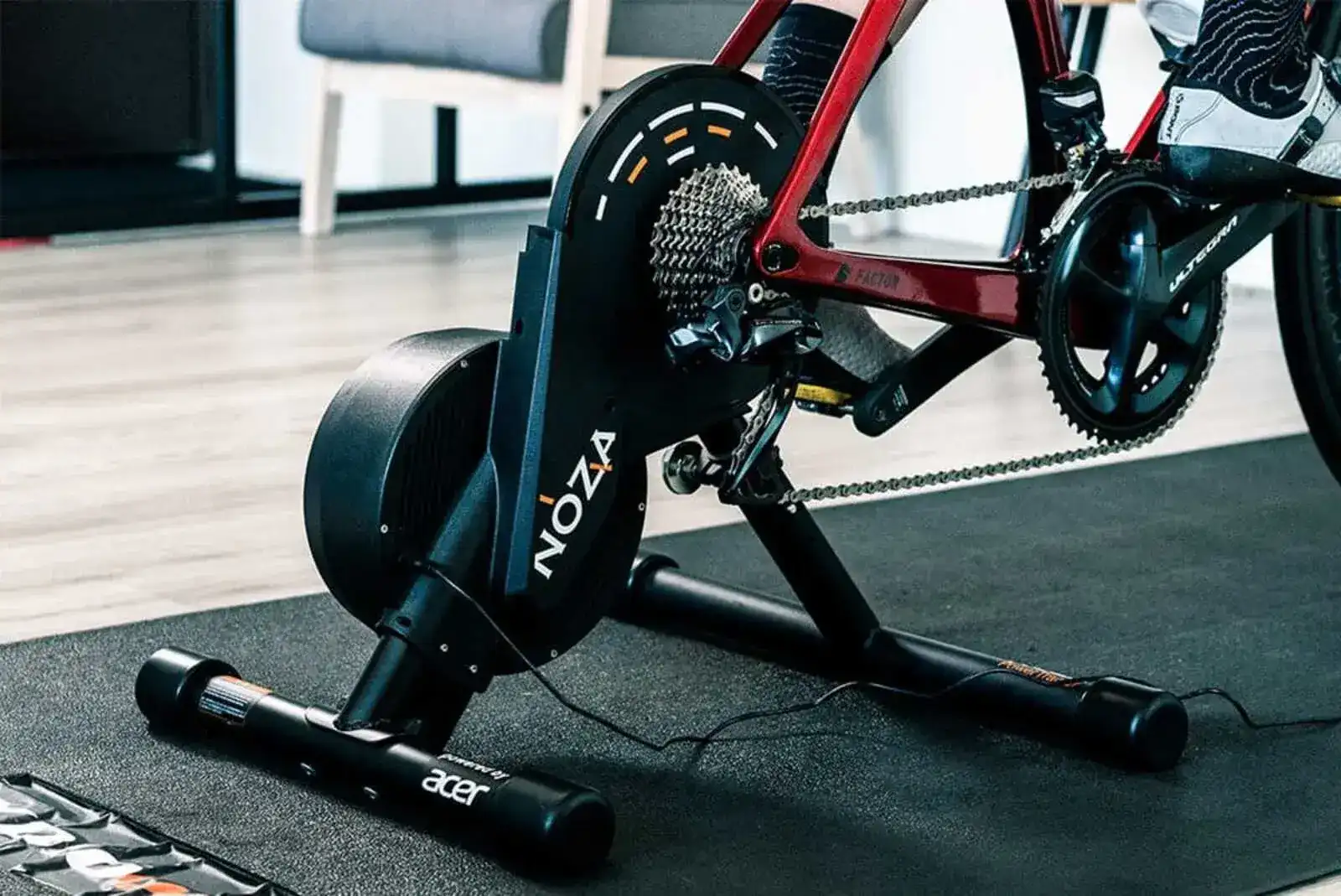
Because there’s no rear tire rubbing against a roller, the training is much quieter.
More autonomous than resistance-based home trainers, they are also pricier. Nonetheless, it’s a worthwhile investment considering the numerous advantages in terms of comfort, silence, and ease of use.
How to Mount Your Bike on a Home Trainer?
Ready to ride in front of the TV? Grab your bike and let’s begin.
- Lock or remove the rear wheel
On a typical connected home trainer, simply remove the rear wheel axle and install the supplied one to stabilize the bike.
Next, position this new axle at the end of the home trainer’s forks and tighten the nuts securely. To apply resistance that mimics road feel, attach the roller against the wheel.
- Connect your bike to receive pedaling data
Once the bike is stable and ready to ride, the next step is to establish the connection. Connect the cable from the roller to the handlebars, for instance, to adjust the workout intensity.
Once connected to your smartphone or computer via Bluetooth, you’ll receive real-time data about your session.
How to Choose Your Connected Home Trainer
Here’s a summary of features to consider when choosing a connected home trainer from the market:
| Resistance Home trainer | Direct-drive home trainer |
| More precise and easily adjustable resistance. More realistic sensations. Less noise. | Less expensive. Often lighter. Quick to assemble. |
| More expensive. You have to remove the rear wheel and mount the bike on a cassette. | Less precise and less stable. Some models are noisy. Each session must be manually calibrated. |
Here are specific selection criteria to consider when choosing the right home trainer for your needs:
- Compatibility with your bike model.
- Maximum power capability.
- Range of resistance levels available.
- Interactivity features.
- Ease of installation and attachment.
- Portability and weight, especially if you need to transport it.
Home Trainer Workout Examples
Once your home trainer is set up, you can engage in various types of workouts. Here are three examples you can try at home.
Maximum Aerobic Power (MAP) Session
- Begin with a few minutes of progressive warm-up. In the final 5 minutes, perform several accelerations to elevate your heart rate.
- Perform a pyramid workout: alternate between 1 minute fast and 1 minute slow, then 2 minutes fast followed by 2 minutes slow, and so on. Repeat this sequence 2 to 3 times. Rest for 2 minutes between each set of 6 intervals. Maintain a high cadence (i5).
- Cool down for 10 minutes and stay hydrated.
VO2 Max and Power Session
- Begin with a 15-minute warm-up at a moderate pace (i3).
- Perform two sets of 6 accelerations: 30 seconds at i5 followed by 30 seconds at i2. Allow the machine to run for 3 to 5 minutes between sets.
- Cool down for 10 minutes.
Endurance Session
- Begin with a 20-minute progressive warm-up: 4 minutes at i1, 4 minutes at i2, 6 minutes at i3, and 6 minutes at i2.
- Perform a pyramid workout: 2 minutes at i3, 1 minute at i2, 4 minutes at i3, 1 minute at i2, 5 minutes at i3, 1 minute at i2, 4 minutes at i3, 1 minute in i2, and 3 minutes at i3. Maintain an average cadence of around 100 RPM. Optionally, add 1 or 2 additional sets of 4 minutes at i3 if desired.
- Cool down for 10 minutes.
Exercise Intensity Levels (i1, i2, i3…)
| Intensity | Cyclist’s sensations |
| i1 | Pedaling is very easy, with minimal fatigue. |
| i2 | Moderate intensity, muscles begin to warm up without discomfort. |
| i3 | Increased muscle tension, breathing rate starts to increase. |
| i4 | Talking becomes difficult, heart rate increases rapidly, legs begin to tingle. |
| i5 | Significant effort, challenging after 4 minutes. |
| i6 | Rapid onset of pain in lower limbs accompanied by hyperventilation. |
| i7 | Severe neurological fatigue, exhaustion sets in rapidly. |
Conclusion
Numerous sports enthusiasts highly recommend having a home trainer in their living room or garage.
The Zwift application, available on connected home trainers, allows you to participate in virtual races and fantasy competitions with other cyclists. This intelligent home trainer feature is boosting sales in sports shops.
Riding an electric bike is a form of exercise, and the home trainer is an effective and enjoyable method of working out when unable to leave the house. You can engage in various workout sessions to pursue your passion at home or simply stay fit!
Our Favorite Home Trainers

Elite Novo Mag Force
Silent, grippy elastogel roller, 5 resistance levels, fast-fix system and foldable for easy storage.
Resistance: Magnetic | Bicycle type: road | Max load: 286 lbs | Warranty: 2 years

Elite Turno
Compatible with many applications, silent, max power 700W, fluid resistance, ultra-precise Misuro B+ sensor.
Resistance: Fluid | Bicycle type: road | Max load: 286 lbs | Warranty: 2 years

Ultrasport Roller trainer
7 resistance levels, foldable and silent, suitable for all bikes with or without quick-release. Can support up to 220 lbs.
Resistance: Magnetic | Bicycle type: All | Max load: 220 lbs | Warranty: 2 years

Elite Qubo Fluid
1-gesture fast-fix system, ultra-resistant sensor. Adherent Elastogel roller, compass system to simulate the road.
Resistance: Fluid | Bicycle type: road | Max load: 286 lbs | Warranty: 2 years

Sportneer
Foldable with noise-reducing wheel, easy to assemble and use with lever clamp. 6 resistance levels.
Resistance: Magnetic | Bicycle type: road | Max load: 220 lbs | Warranty: 1 year

